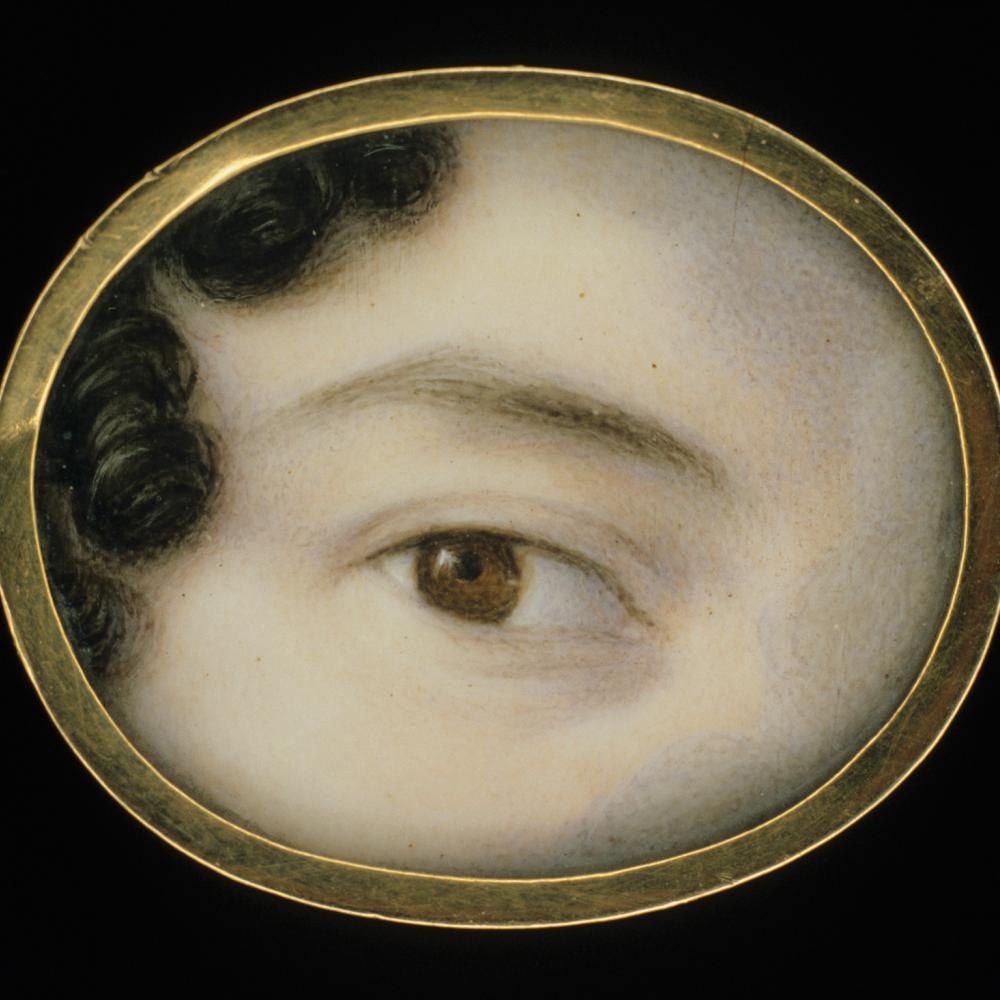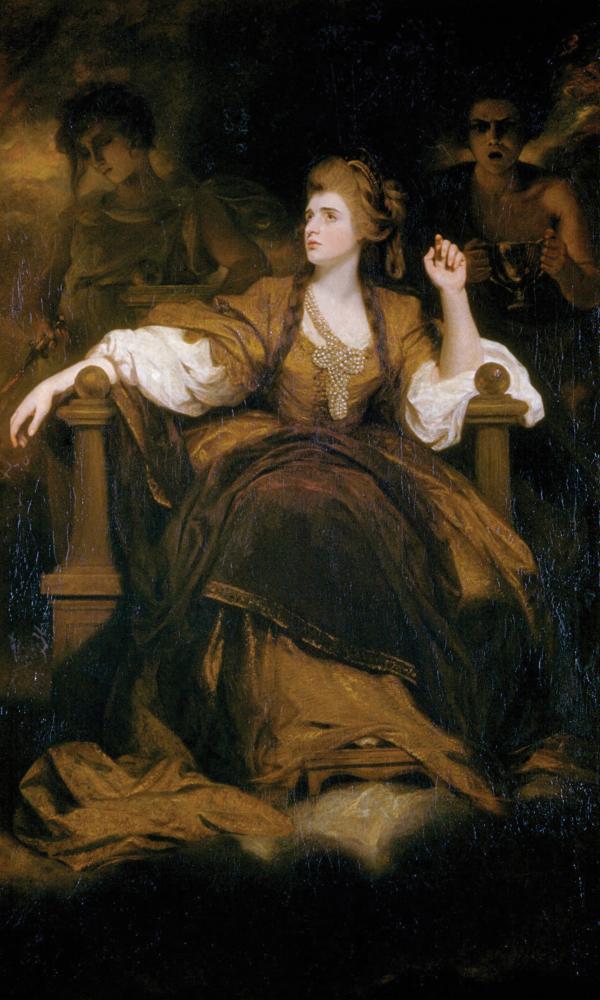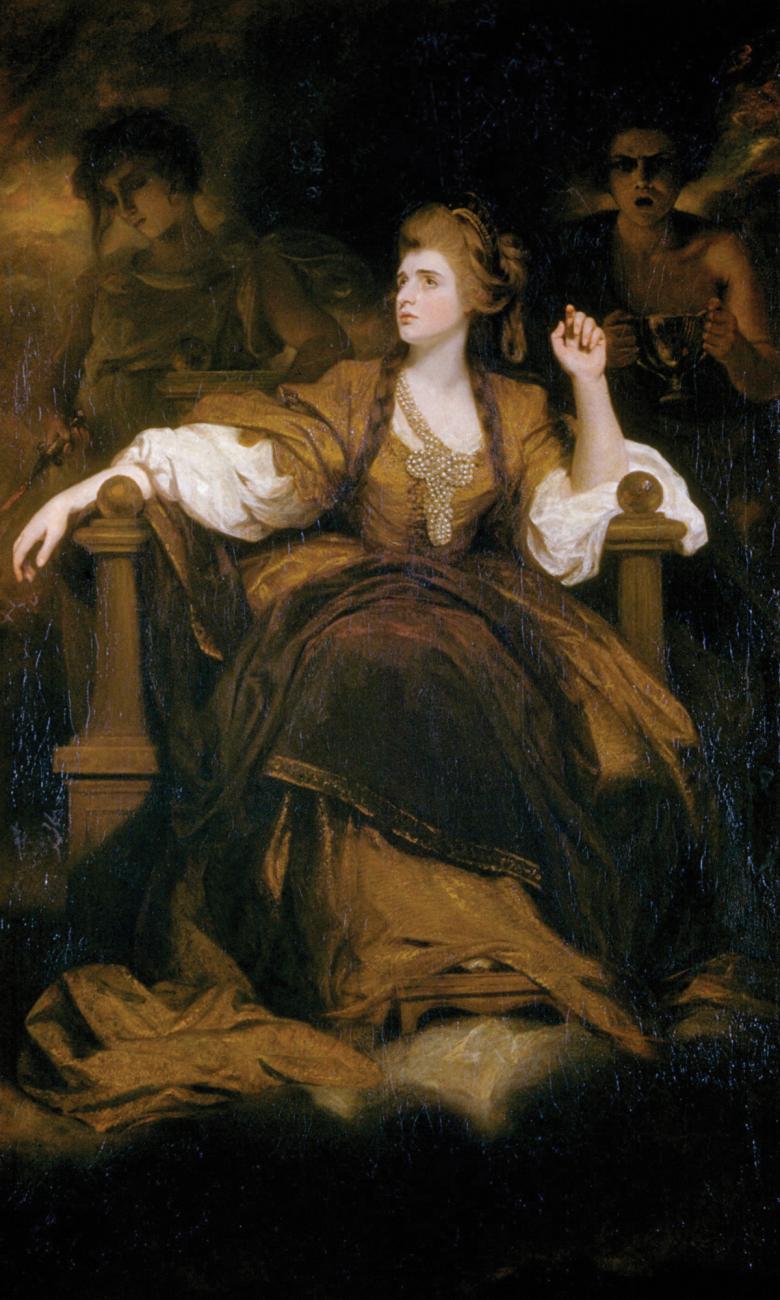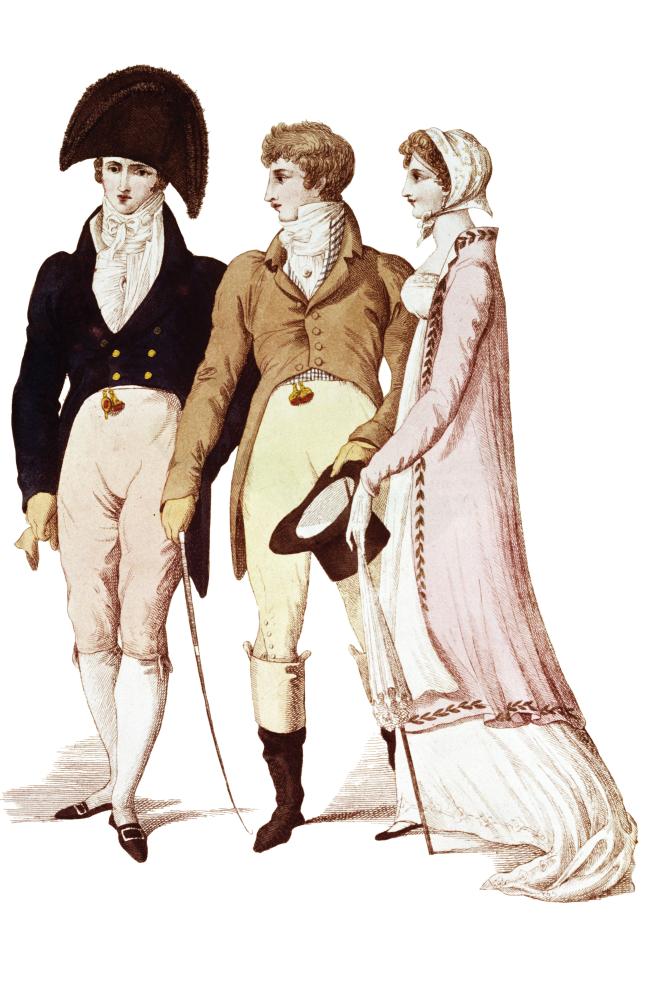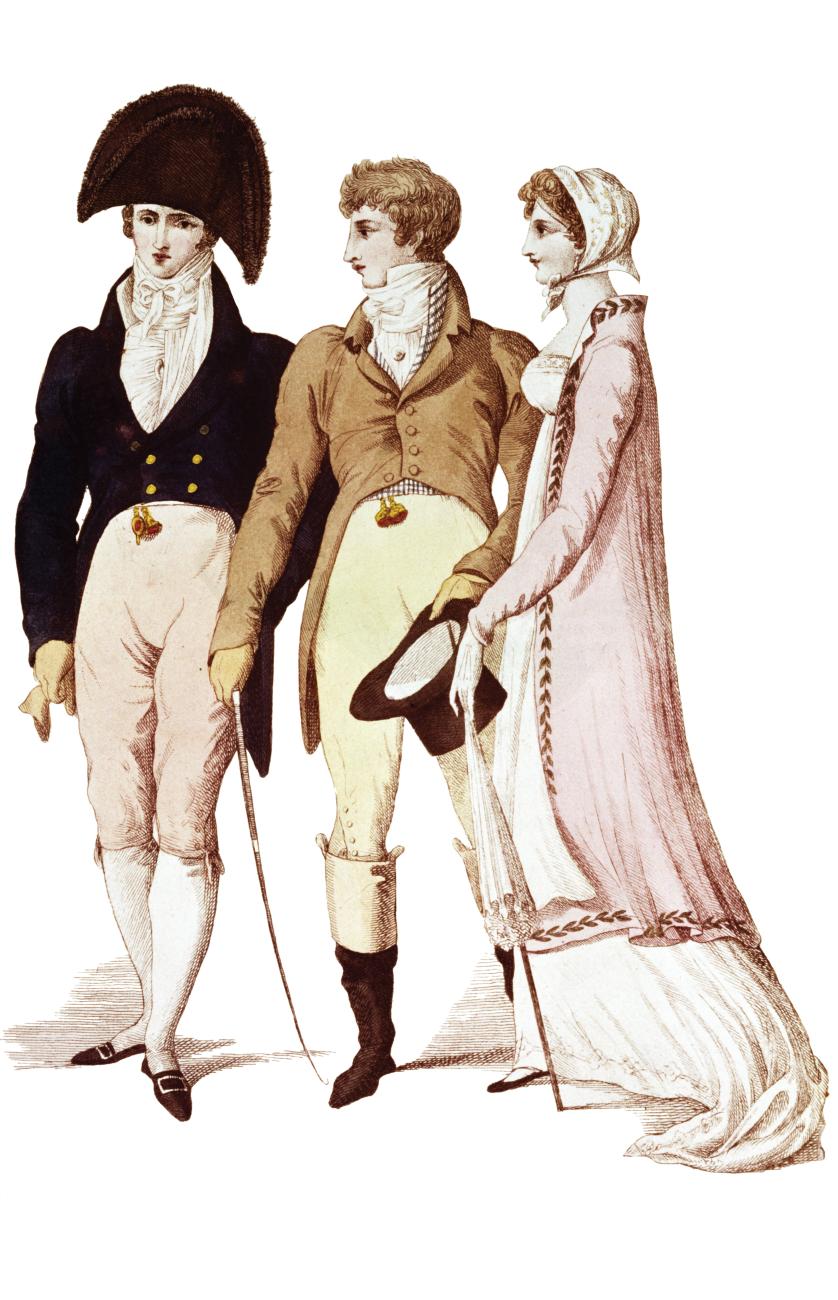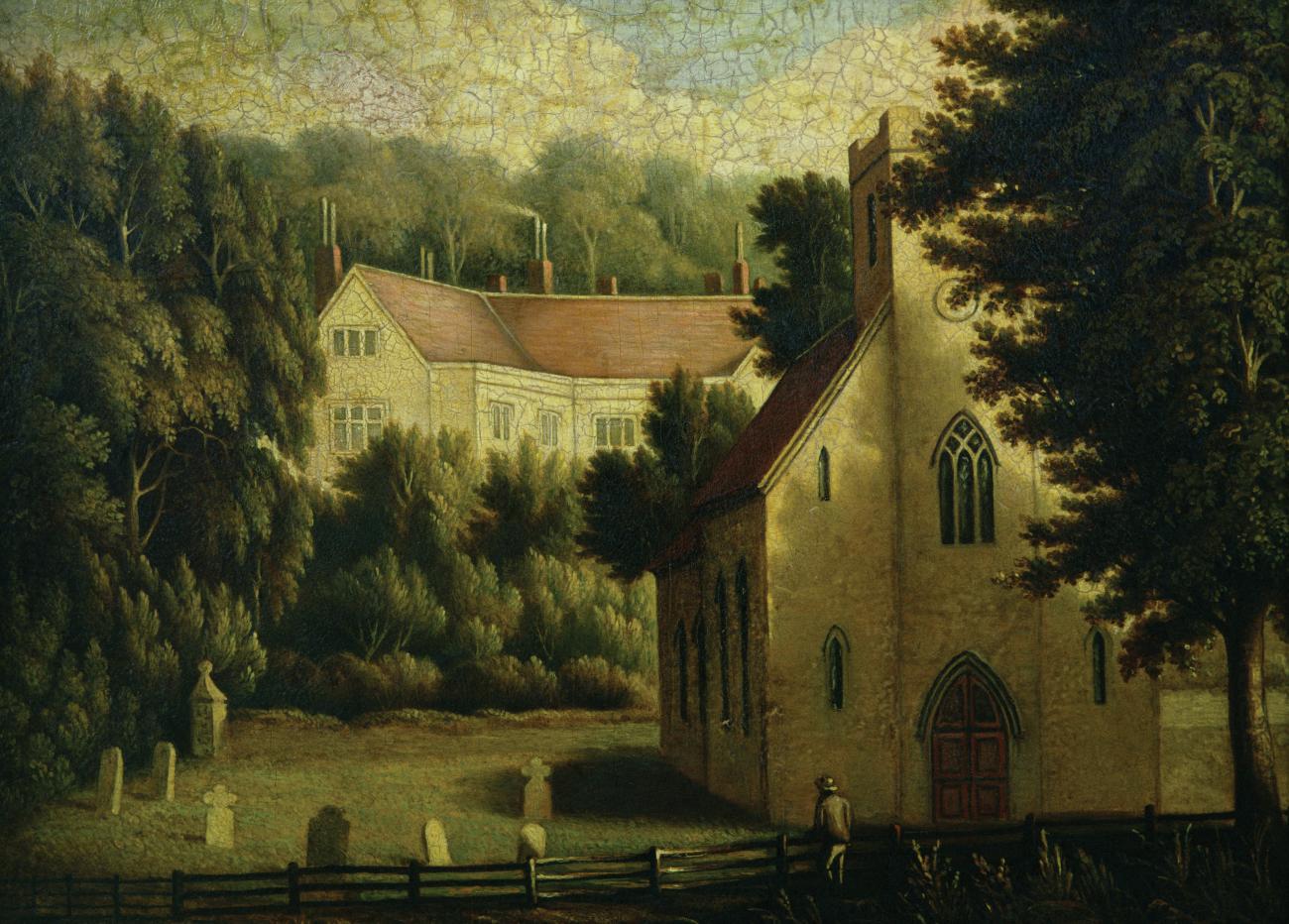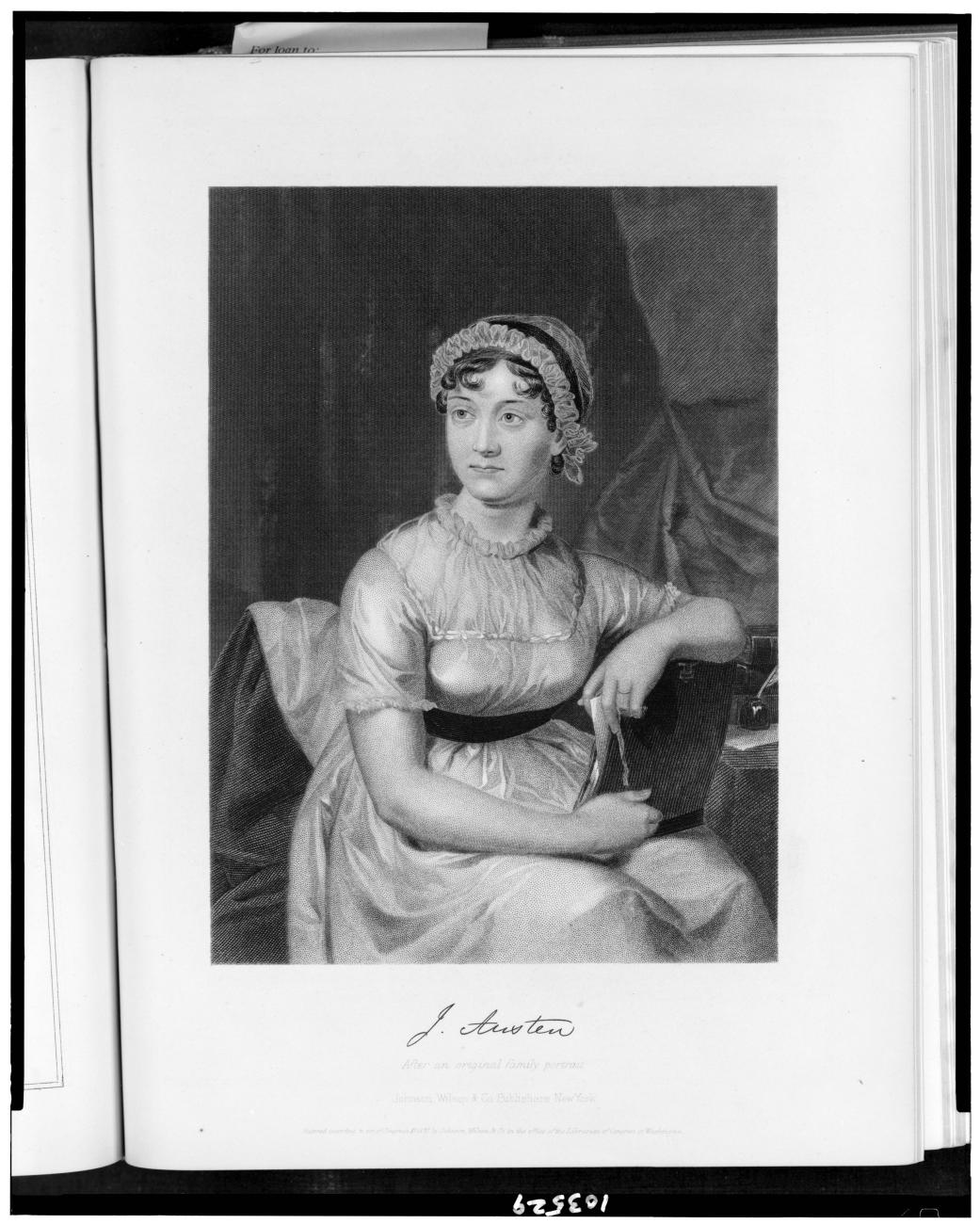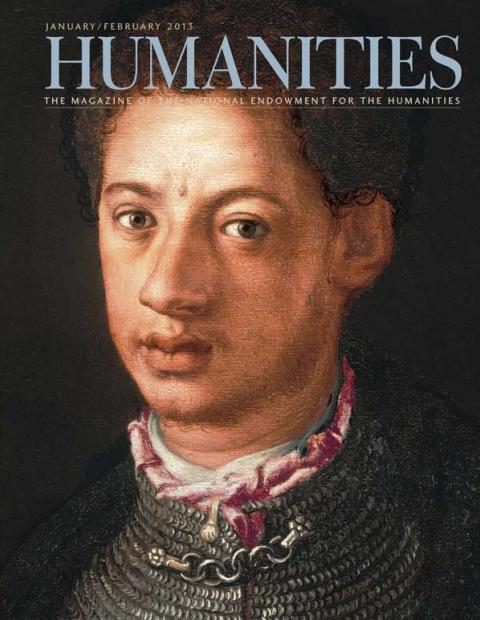In May 1813, Jane Austen mingled among London's fashionable crowd as she took in an exhibition of oils and watercolors at Wigley ’s Great Room at Spring Gardens. Since the beginning of the year, the “ton” had been chattering about and passing around a delicious new book, Pride and Prejudice, which chronicled the travails of the Bennet sisters as they navigated the marriage market. The author, to the dismay of polite society, remained anonymous. So it was with some ease that Austen strolled through the gallery playing a secret game: Which of the portraits that hung on the walls looked like the characters she had created for Pride and Prejudice? Might she see the sweet Jane who marries the equally pleasant-tempered Mr. Bingley? Or Elizabeth, whose fine eyes and formidable wit crack the shell of the aloof Mr. Darcy?
Austen finally stumbled upon a portrait that she thought looked liked Jane or “Mrs. Bingley.” “Mrs. Bingley’s is exactly herself, size, shaped face, features & sweetness; there was never a greater likeness. She is dressed in a white gown, with green ornaments, which convinces me of what I had always supposed, that green was a favorite colour with her,” she wrote her sister Cassandra. Austen didn’t see “Mrs. Darcy ” in any of the portraits, but suspected that her heroine would have been wearing yellow.
A few days later, Austen played the same game when she attended an exhibition of paintings by Sir Joshua Reynolds at the Royal Academy at Somerset House. “Mrs. Darcy ” once again proved elusive. A disappointed Austen told Cassandra that “I can only imagine that Mr D. prizes any Picture of her too much to like it should it be exposed to the public eye.” Darcy, she believed, would regard Elizabeth with a mixture of “Love, Pride & Delicacy.”
It’s not surprising to see Austen think of her characters as living, breathing people. Austen had lived with Elizabeth, Jane, Bingley, and Darcy for more than fifteen years. She began writing Pride and Prejudice when she was twenty, working on the book from October 1796 to August 1797. But Pride and Prejudice wasn’t published until January 1813, which raises the question of what caused such an extended delay between its writing and publication.
For the past two centuries, historians and literary scholars have attempted to solve the mystery that is Jane Austen’s life. How did a woman from a small village in Hampshire come to write six of the most beloved novels in the English language? Their search for answers has been complicated by the fact that Austen lived a quiet life. Women didn’t leave much of a historical footprint in the eighteenth and nineteenth centuries.
If you assumed that Austen was a regular letter writer, you’d be correct, but the majority of those letters and her personal archive were destroyed. Cassandra, who served as her executor, scissored some letters and burned hundreds more. Other letters held by the family were destroyed over the years as well. In 1990, when Jo Modert published Jane Austen’s Manuscript Letters in Facsimile, a project undertaken with NEH support, there were 130-odd known Austen letters. The count is now up to 160. What remains is illuminating. Scholars have used the letters, along with family diaries, correspondence by friends and family, and county records to reconstruct much of Austen’s life. When everything is assembled, it reveals a woman at the mercy of her family ’s finances for her very existence, yet nurtured and supported by her relatives when they recognized an uncommon talent in their midst.
The Surety of Steventon
Austen was born on December 16, 1775, which was a month later than her parents, George and Cassandra, reckoned she should arrive. With six other children—James, George, Edward, Henry, Cassandra, and Francis—the Austens might have been more adept at counting the weeks. They were happy for the arrival of another daughter, and George, a parson, baptized Jane at home. Another brother, Charles, followed four years later, marking an end to the family ’s expansion, much to the relief of the household’s budget. The Austens were continually strapped for money, even though the parsonage at Steventon, a small village in Hampshire, provided a living. Three years before Jane’s birth, the Austens opened a school for boys as a way to earn extra income. Every fall and spring, the parsonage, with its seven bedrooms and three attics, filled up with young men in need of tutoring. From an early age, Austen’s world was full of boyish antics, bawdy humor, and outdoor exploration.
Leaving that rough-and-tumble world behind, seven- year-old Jane was sent, along with her sister Cassandra, to a girls’ school in Oxford. The Austen girls stayed only a year, returning home after both became ill from typhoid. Jane and Cassandra passed a year at Steventon before being enrolled in Mrs. La Tournelle’s Ladies’ Boarding School in Reading, where they again stayed only a year. Austen’s experience, however brief, left her with little regard for girls’ schools. In Emma, she writes scathingly of schools that “professed, in long sentences of refined nonsense, to combine liberal acquirements with elegant morality upon new principles and new systems—and where young ladies for enormous pay might be screwed out of health and into vanity.”
Austen’s departure from Mrs. La Tournelle’s School put an end to her formal education at age ten. The adult Jane claimed to be “a woman who like me knows only her mother tongue, and has read little in that . . . I think I may boast myself to be, with all possible vanity, the most unlearned and uninformed female who ever dared to be an authoress.” Self-deprecation aside, Austen was far from “unlearned”—indeed, it would have been difficult for her to escape getting an education. George Austen kept a sizable library—one bookcase reportedly covered sixty-four square feet of wall—which his children were encouraged to explore. There were ongoing science experiments and constant engagement with the natural world. Dinner table conversations, which included George’s pupils, ran onphilosophy, literature, and science, along with dashes of racing, horses, and neighborhood gossip.
The Austen household revolved around language. Henry once described his father as “a profound scholar, professing a most exquisite taste in every species of literature.” Mother Cassandra wrote humorous verses, while the brothers dabbled in essays and playwriting. We know that Jane read Samuel Richardson from cover to cover, plowed through Hume’s History, and marked up Goldsmith’s History of Eng-land and Dodsley ’s Collection of Poems. She also read popular works, such as Fanny Burney ’s Camilla. And, despite her protestations, Austen probably spoke passable French and knew enough Italian to translate opera, as she has Anne Elliot do in Persuasion.
When young Jane showed a spark of talent for writing, her father encouraged his budding author, buying her journals and writing paper, both expensive commodities. In the front of one journal, given to her around her seventeenth year, George wrote: “Effusions of Fancy by a very Young Lady Consisting of Tales in a Style entirely new.” Austen wasn’t afraid to experiment, trying her hand at playwriting, as well as a novel with a morally suspect heroine. When she was nineteen, Austen began working on “Elinor and Marianne,” the precursor to Sense and Sensibility, which chronicles how the Dashwood sisters reconciled their hearts to the brutal realities of the marriage market for women without means. Austen understood their predicament well, as neither she nor Cassandra had a dowry, because of their father ’s ongoing financial problems.
Austen received a lesson in the cruel incompatibility of love and money when she fell hard for Tom Lefroy, a twenty-year-old Irishman. She met the “very gentlemanlike,good-looking, pleasant young man” during the Christmas season of 1795–1796 when he came to stay with his Lefroy relatives, who were dear friends of the Austens. In a letter she wrote to Cassandra in early 1796, Austen gushes about Lefroy and worries that her sister will scold her for her behavior. “I am almost afraid to tell you how my Irish friend and I behaved. Imagine to yourself everything most profligate and shocking in the way of dancing and sitting down together. I can expose myself, however, only once more, because he leaves the country soon.” A week later, she was equal parts anticipation and dread at the idea of seeing him at the dance they were to attend that night: “At length the Day is come on which I am to flirt my last with Tom Lefroy.. . . My tears flow as I write, at the melancholy idea.”
Lefroy fell for Austen as well, confessing in later years to a “boyish love” for her, but the match was impossible. As the oldest son of a retired soldier of limited means, he was expected to make a good marriage in order to provide for his five sisters. The neighborhood had taken note of their affection, and his aunt intervened to keep the infatuation from compromising either of them. The dance was the last time Austen laid eyes on him. Lefroy would go on to marry an heiress, return to Ireland, and establish a law practice before ultimately becoming Lord Chief Justice of Ireland.
Austen began “First Impressions,” which would become Pride and Prejudice, in the fall of 1796, working on it for the next year. She had already begun exploring the implications of a woman professing her feelings—or keeping them closely guarded—in “Elinor and Marianne.” That theme again appeared in “First Impressions,” when Jane almost loses out on marrying Bingley because she is not regarded as effusive enough in her adoration of him. The plot is also driven by the lack of dowries for the Bennet sisters. Austen has her heroine Elizabeth refuse a sure-to-be-trying marriage to the odious Mr. Collins, a loquacious clergyman, despite the financial advantages of the match, which included being able to stay in the family home. Elizabeth would rather remain single, even penniless, than settle for anything less than affection. In the end, she earns the respect and love of Mr. Darcy, whose vast wealth ensures that her family will never want for anything. Given Austen’s interlude with Lefroy, it is hard not to see the plot of “First Impressions” as the author writing a happy ending for herself.
George Austen was so impressed by what his daughter had written that he sent the manuscript to Cadell and Davies, the firm known for publishing Samuel Johnson and Edward Gibbon, in November 1797. “As I am well aware of what consequence it is that a work of this sort should make its first Appearance under a respectable name I apply to you,” wrote George in the cover letter. He also inquired what it would cost to publish the novel, indicating that he was prepared to cover the expense. The package came back with the words “Declined by Return of Post” scrawled on the front.
Betwixt and Between
Between 1795 and 1799, Austen wrote early versions of Sense and Sensibility, Pride and Prejudice, and Northanger Abbey. It’s an extraordinary period of productivity, particularly given that she was still in her early twenties. That makes the dearth of writing over the next decade a bit of a puzzle. The letters that survive don’t hint at writer ’s block or a lack of interest in writing. Instead, they reveal a life in a constant state of upheaval.
In 1801, George Austen gave up his post at Steventon, and the family, which now numbered four (father, mother, sister Cassandra, and Jane), moved to Bath. Jane’s brothers had already ventured forth to make their way. James, the eldest, succeeded his father as the parson of Steventon. Edward was learning how to be a wealthy landowner. The Knights, a childless couple with ties to the Austen family,had grown fond of Edward when he was a young boy, and offered to adopt him in return for making him heir to their estates. Henry, Jane’s favorite brother, spent time in the Oxford Militia before embarking on a career as a banker. Francis and Charles both became officers in the Royal Navy, which meant long stretches at sea and constant worry by their family about their fate. Little is known about George, except that he was disabled and his care was arranged for outside the family.
While the Austens resided in Bath, there were also frequent trips to the Devon and Dorset coasts to assuage her father ’s newfound travel bug. Despite its charming architecture and cultural offerings, Bath was not to Jane's liking. She found town life claustrophobic and missed the extensive network of family and friends in Steventon. There were also personal challenges: Austen nursed her mother through a long illness and helped Cassandra move past the grief of losing her fiancé, Thomas Fowle. The penniless Fowle had agreed to serve as a chaplain to a military expedition in the West Indies in exchange for being provided with a well-situated vicarage in Shropshire upon his return. It was an ambitious decision that ended not with a longed-for marriage to Cassandra, but death from yellow fever.
In December 1802, Austen received an unexpected marriage proposal. Her friends Alethea and Catherine Bigg decided to play matchmaker between Austen and their baby brother, Harris. The tall, strapping Harris was five years younger than Austen and had just completed his studies at Oxford. As the heir to a sizable estate, he could provide a comfortable life for a wife. Harris was a sweet boy but socially awkward. Austen agreed to the match, flattered by his regard and the security the marriage could provide for herself and her family, but after sleeping on it for a night, she reconsidered. “She esteemed him, she was honoured by his proposal, but on thinking it over she realized that esteem and respect were not enough, and that she would not be behaving fairly or rightly towards him if she accepted the offer of his hand,” writes biographer Claire Tomalin.
In the wake of the marriage proposal, Austen briefly returned to writing, revising the manuscript for Northanger Abbey, which follows the adventures of seventeen-year-old Gothic novel enthusiast Catherine Moreland. In early 1803, Henry arranged for the novel to be offered to Crosby and Co., a London publisher, which paid £10 for it. An advertisement soon followed, trumpeting that it was on press, but the novel never appeared.
Austen must have been disappointed, but she soldiered on, beginning work on “The Watsons,” the story of a group of unmarried sisters who are anxious to make matches before their clergyman father dies. This time, fiction would mimic life, when George Austen died in January 1805. Austen wrote to her brother Francis that their father had “oppression in the head, with fever, violent tremulousness, & the greatest degree of Feebleness,” eventually passing in his sleep after becoming “insensible.” Austen set aside “The Watsons” not long after. Her nephew, James Austen-Leigh, suggests in A Memoir of Jane Austen that plot problems, namely setting the family too far down the social scale, caused her to abandon the story. But Tomalin notes that Austen planned to kill off Mr. Watson, so it is easy to see what an emotional challenge it would have been for her to keep working on the novel given the parallels to her own life.
“The loss of such a Parent must be felt, or we should be Brutes,” wrote Austen. George Austen’s death was both an emotional and financial blow to his wife and daughters. While Mother Austen and Cassandra both had small savings, Jane was penniless and entirely dependent on her family. It fell to her brothers to supplement their living and help settle them someplace comfortable. “Seven years I suppose are enough to change every pore of one’s skin, & every feeling of one’s mind,” Austen wrote Cassandra, reflecting back on the events that had led her to such a perilous position.
The Austen women bounced between family and friends before settling in Southampton. As she entered her early thirties, Austen was regarded as the beloved maiden aunt to a flock of nieces and nephews. She apparently also dressed the part. “She and her sister were generally thought to have taken to the garb of middle age earlier than their years or their looks required; and . . . were scarcely sufficiently regardful of the fashionable, or the becoming,” wrote her nephew. Austen regularly journeyed to Steventon to spend time with James and his three children. At Godmersham, the estate Edward inherited upon becoming Knight’s heir, she helped mind his eleven children. Francis and Mary ’s family also grew rapidly, eventually numbering eleven. Wherever she was, there were children underfoot who needed to be entertained and nurtured.
A Cottage of One’s Own
In July 1809, the Austen women left Southampton to take up residence in Chawton, a small village about fifty miles from London. A cottage with six bedrooms and a sizable garden had become available on Edward’s estate and he offered to fix it up for them. The move put Austen back in the Hampshire of her youth: It was only twelve miles to Steventon, where James lived, and one mile to Alton, where Henry had a branch of his bank. At Chawton, Austen’s sole chore was to make nine o’clock breakfast, which consisted of tea and toast, leaving her free to write the rest of the day. The cottage seems to have provided Austen with the conditions she needed to thrive as a writer once again, and she immediately began revising Sense and Sensibility. Her nephew gives what has become an almost legendary account of her habits:
She was careful that her occupation should not be suspected by the servants, or visitors, or any persons beyond her only family party. She wrote upon small sheets of paper which would easily be put away, or covered with a piece of blotting paper. There was, between the front door and the offices, a swing door which creaked when it was opened; but she objected to having this little inconvenience remedied, because it gave her notice when anyone was coming in.
It’s a rosy picture, perhaps too idyllic, but it speaks to her desire to keep her writing secret, one that would persist as she tried her hand at publication again.
In late 1810, Thomas Egerton of the Military Library agreed to publish Sense and Sensibility. It’s not clear how the manuscript came to Egerton, but Henry ’s army connections may have played a role. Egerton agreed to take the three-volume novel on commission, which meant that Austen bore the financial risk. She paid for printing, advertising, and distribution, but kept the copyright. Of course, “she paid” meant Henry did because Austen had no money of her own.
“No indeed, I am never too busy to think of S&S,” wrote Austen in the middle of correcting proofs in April 1811. “I can no more forget it, than a mother can forget her sucking child.” By the fall, the novel was fully typeset and a notice appeared in The Morning Chronicle on October 31, 1811, announcing “A New Novel by a Lady.” Austen would eventually make a profit of £140, no small sum for a woman who had never had her own money.
When Sense and Sensibility proved a success—with both favorable reviews and chatter among the ton—Egerton was eager to publish another novel. Austen hadn’t been idle, having turned her attention to revising “First Impressions.” “I have lop’d and crop’t so successfully that I imagine it must be rather shorter than S. and S.,” wrote Austen. No manuscripts have survived, so it is hard to know how much chopping she did. R. W. Chapman, the dean of Austen scholars, speculates that Austen made adjustments, but was careful to preserve the spirit of the novel written fifteen years earlier. “On the whole, it is difficult to resist the conclusion that Pride and Prejudice is largely the work of its author ’s maturity. Yet it retains a youthful exuberance which the experienced spinster, nearing forty, could hardly recapture.” There’s also the fact that Austen thinks of Jane, Elizabeth, Darcy, and Bingley as contemporary characters by virtue of looking for them among the galleries.
Austen also had to pick a new title, as a book with the title “First Impressions” had been published in 1800. She settled on Pride and Prejudice, most likely taking inspiration from Fanny Burney ’s novel, Cecilia. Austen was a fan of Burney, and the final paragraph of Cecilia features the phrase “PRIDE AND PREJUDICE” (in caps no less) three times.
“P. & P. is sold.—Egerton gives £110 for it.—I would rather have had £150, but we could not both be pleased, & I am not at all surprised that he should not chuse to hazard, so much.—Its’ being sold will I hope be a great saving of Trouble to Henry, & and therefore must be welcome to me,” wrote Austen in November 1812. Under this arrangement, Egerton would shoulder the costs of producing the book. Austen agreed to a lesser amount to avoid having to depend on Henry to finance the printing.
When Pride and Prejudice was published in January 1813—three volumes for 18 shillings—Egerton advertised it as the work of the author of Sense and Sensibility. Austen chose to remain anonymous again, even with their neighbors. When Miss Benn dined with them on the day the books arrived at Chawton, Austen and her mother took turns reading from volume one. “I beleive it passed with her unsuspected.—She was amused, poor soul! that she cd not help you know, with two such people to lead the way; but she really does seem to admire Elizabeth. I must confess that I think her as delightful a creature as ever appeared in print, & how I shall be able to tolerate those who do not like her at least, I do not know.”
Like many an author, Austen fretted over errors that had cropped into the book. She thought that a few more “he said”s or “she said”s might have made the dialog “more immediately clear,” but consoled herself with the thought that she did not “write for such dull Elves.” She worried about a wrong word and regretted that a typographical error turned two speeches into one. Despite these glitches, Austen was fundamentally happy with how her “darling Child” fared in the world. The reviews were also favorable. Critical Review praised Elizabeth, noting that her “sense and conduct are of a superior order to those of the common heroines of novels. From her independence of character, which is kept within the proper line of decorum, and her well-timed sprightliness, she teaches the man of Family-Pride to know himself.” The reviewer for British Critic “perused these volumes with much satisfaction and amusement,” and entertained “very little doubt that their successful circulation will induce the author to similar exertions.”
As the reviewer hoped, more books followed: Mansfield Park (1814) and Emma (1815). As Austen worked on the manuscript that would become Persuasion, her health started to decline and she struggled to keep her energy up. The nature of Austen’s illness remains a mystery and scholars have speculated that she suffered from everything from Addison’s disease to tuberculosis to Hodgkin’s lymphoma to a recurrent form of typhus. Whatever wracked her body, by the spring of 1817, Austen was bedridden, and on July 18, 1817, she passed away. Six months after her death, in December 1817, two more novels were published: Northanger Abbey and Persuasion.
While Austen was fashionable during her lifetime, she has become beloved in the two centuries since. Pride and Prejudice, in particular, holds a special place in modern readers’ hearts. In a poll done by BBC in 2003 to determine the UK’s best-loved novel, Pride and Prejudice came in second behind J.R.R. Tolkien’s The Lord of the Rings. It’s been adapted for stage, television, and film countless times. There have also been iterations as varied as they are inventive. Film director Gurinder Chadha reimagined the novel as a Bollywood musical in Bride and Prejudice, while Seth Grahame-Smith mashed it up with the monster genre to create the hybrid novel Pride and Prejudice and Zombies. Helen Fielding used Austen’s plot as a template for Bridget Jones’ Diary. P. D. James extended the story, casting Elizabeth and Darcy as detectives in Death Comes to Pemberley.
While marriage might be the central force of Pride and Prejudice—after all, the novel opens with the now-legendary line “It is a truth universally acknowledged, that a single man in possession of a good fortune, must be in want of a wife”—the novel has endured because of the other universals Austen captured: money woes, troublesome sisters, unwanted suitors, embarrassing mothers, meddlesome neighbors, snap judgments, the trauma of public humiliation, the agony of not knowing if your love is returned, and the desire for a happy-ever-after ending.
“Also read again and for the third time at least Miss Austen’s very finely written novel of Pride and Prejudice,” wrote Sir Walter Scott in March 1826. Scott was known for sweeping historical romances, but he also valued Austen’s limited canvas. “That young lady had a talent for describing the involvements and feelings and characters of ordinary life which is to me the most wonderful I ever met with. The Big Bow-wow strain I can do myself like any now going; but the exquisite touch, which renders ordinary commonplace things and characters interesting, from the truth of the description and the sentiment, is denied to me. What a pity such a gifted creature died so early.”

